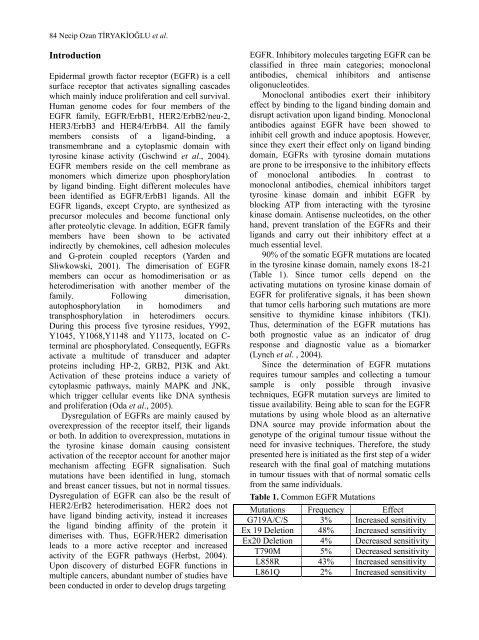Vol 9 No1 - Journal of Cell and Molecular Biology - Haliç Üniversitesi
Vol 9 No1 - Journal of Cell and Molecular Biology - Haliç Üniversitesi
Vol 9 No1 - Journal of Cell and Molecular Biology - Haliç Üniversitesi
Create successful ePaper yourself
Turn your PDF publications into a flip-book with our unique Google optimized e-Paper software.
84 Necip Ozan TİRYAKİOĞLU et al.<br />
Introduction<br />
Epidermal growth factor receptor (EGFR) is a cell<br />
surface receptor that activates signalling cascades<br />
which mainly induce proliferation <strong>and</strong> cell survival.<br />
Human genome codes for four members <strong>of</strong> the<br />
EGFR family, EGFR/ErbB1, HER2/ErbB2/neu-2,<br />
HER3/ErbB3 <strong>and</strong> HER4/ErbB4. All the family<br />
members consists <strong>of</strong> a lig<strong>and</strong>-binding, a<br />
transmembrane <strong>and</strong> a cytoplasmic domain with<br />
tyrosine kinase activity (Gschwind et al., 2004).<br />
EGFR members reside on the cell membrane as<br />
monomers which dimerize upon phosphorylation<br />
by lig<strong>and</strong> binding. Eight different molecules have<br />
been identified as EGFR/ErbB1 lig<strong>and</strong>s. All the<br />
EGFR lig<strong>and</strong>s, except Crypto, are synthesized as<br />
precursor molecules <strong>and</strong> become functional only<br />
after proteolytic clevage. In addition, EGFR family<br />
members have been shown to be activated<br />
indirectly by chemokines, cell adhesion molecules<br />
<strong>and</strong> G-protein coupled receptors (Yarden <strong>and</strong><br />
Sliwkowski, 2001). The dimerisation <strong>of</strong> EGFR<br />
members can occur as homodimerisation or as<br />
heterodimerisation with another member <strong>of</strong> the<br />
family. Following dimerisation,<br />
autophosphorylation in homodimers <strong>and</strong><br />
transphosphorylation in heterodimers occurs.<br />
During this process five tyrosine residues, Y992,<br />
Y1045, Y1068,Y1148 <strong>and</strong> Y1173, located on Cterminal<br />
are phosphorylated. Consequently, EGFRs<br />
activate a multitude <strong>of</strong> transducer <strong>and</strong> adapter<br />
proteins including HP-2, GRB2, PI3K <strong>and</strong> Akt.<br />
Activation <strong>of</strong> these proteins induce a variety <strong>of</strong><br />
cytoplasmic pathways, mainly MAPK <strong>and</strong> JNK,<br />
which trigger cellular events like DNA synthesis<br />
<strong>and</strong> proliferation (Oda et al., 2005).<br />
Dysregulation <strong>of</strong> EGFRs are mainly caused by<br />
overexpression <strong>of</strong> the receptor itself, their lig<strong>and</strong>s<br />
or both. In addition to overexpression, mutations in<br />
the tyrosine kinase domain causing consistent<br />
activation <strong>of</strong> the receptor account for another major<br />
mechanism affecting EGFR signalisation. Such<br />
mutations have been identified in lung, stomach<br />
<strong>and</strong> breast cancer tissues, but not in normal tissues.<br />
Dysregulation <strong>of</strong> EGFR can also be the result <strong>of</strong><br />
HER2/ErB2 heterodimerisation. HER2 does not<br />
have lig<strong>and</strong> binding activity, instead it increases<br />
the lig<strong>and</strong> binding affinity <strong>of</strong> the protein it<br />
dimerises with. Thus, EGFR/HER2 dimerisation<br />
leads to a more active receptor <strong>and</strong> increased<br />
activity <strong>of</strong> the EGFR pathways (Herbst, 2004).<br />
Upon discovery <strong>of</strong> disturbed EGFR functions in<br />
multiple cancers, abundant number <strong>of</strong> studies have<br />
been conducted in order to develop drugs targeting<br />
EGFR. Inhibitory molecules targeting EGFR can be<br />
classified in three main categories; monoclonal<br />
antibodies, chemical inhibitors <strong>and</strong> antisense<br />
oligonucleotides.<br />
Monoclonal antibodies exert their inhibitory<br />
effect by binding to the lig<strong>and</strong> binding domain <strong>and</strong><br />
disrupt activation upon lig<strong>and</strong> binding. Monoclonal<br />
antibodies against EGFR have been showed to<br />
inhibit cell growth <strong>and</strong> induce apoptosis. However,<br />
since they exert their effect only on lig<strong>and</strong> binding<br />
domain, EGFRs with tyrosine domain mutations<br />
are prone to be irresponsive to the inhibitory effects<br />
<strong>of</strong> monoclonal antibodies. In contrast to<br />
monoclonal antibodies, chemical inhibitors target<br />
tyrosine kinase domain <strong>and</strong> inhibit EGFR by<br />
blocking ATP from interacting with the tyrosine<br />
kinase domain. Antisense nucleotides, on the other<br />
h<strong>and</strong>, prevent translation <strong>of</strong> the EGFRs <strong>and</strong> their<br />
lig<strong>and</strong>s <strong>and</strong> carry out their inhibitory effect at a<br />
much essential level.<br />
90% <strong>of</strong> the somatic EGFR mutations are located<br />
in the tyrosine kinase domain, namely exons 18-21<br />
(Table 1). Since tumor cells depend on the<br />
activating mutations on tyrosine kinase domain <strong>of</strong><br />
EGFR for proliferative signals, it has been shown<br />
that tumor cells harboring such mutations are more<br />
sensitive to thymidine kinase inhibitors (TKI).<br />
Thus, determination <strong>of</strong> the EGFR mutations has<br />
both prognostic value as an indicator <strong>of</strong> drug<br />
response <strong>and</strong> diagnostic value as a biomarker<br />
(Lynch et al. , 2004).<br />
Since the determination <strong>of</strong> EGFR mutations<br />
requires tumour samples <strong>and</strong> collecting a tumour<br />
sample is only possible through invasive<br />
techniques, EGFR mutation surveys are limited to<br />
tissue availability. Being able to scan for the EGFR<br />
mutations by using whole blood as an alternative<br />
DNA source may provide information about the<br />
genotype <strong>of</strong> the original tumour tissue without the<br />
need for invasive techniques. Therefore, the study<br />
presented here is initiated as the first step <strong>of</strong> a wider<br />
research with the final goal <strong>of</strong> matching mutations<br />
in tumour tissues with that <strong>of</strong> normal somatic cells<br />
from the same individuals.<br />
Table 1. Common EGFR Mutations<br />
Mutations Frequency Effect<br />
G719A/C/S 3% Increased sensitivity<br />
Ex 19 Deletion 48% Increased sensitivity<br />
Ex20 Deletion 4% Decreased sensitivity<br />
T790M 5% Decreased sensitivity<br />
L858R 43% Increased sensitivity<br />
L861Q 2% Increased sensitivity

















